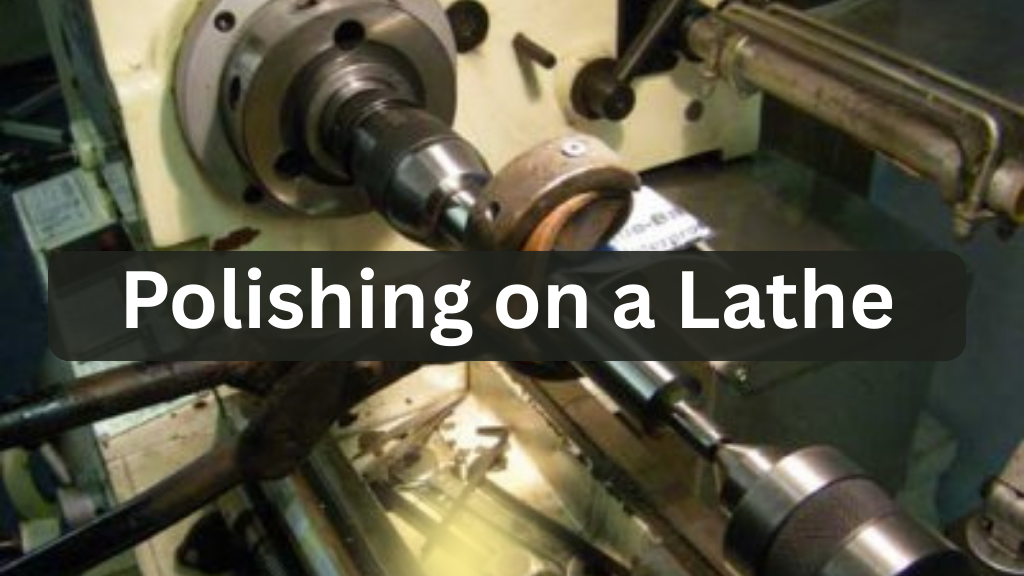Polishing on a lathe is not just about making a workpiece shiny. It is a critical process that improves surface finish, enhances durability, and increases the value of the final product. Whether you are a hobby machinist working in a small garage workshop or a professional in a precision engineering facility, knowing how to polish on a lathe can elevate the quality of your projects to a professional standard.
This guide will walk you through the techniques, tools, safety tips, and material-specific strategies you need to achieve flawless results. It also includes real-world examples, expert tips, and practical advice to help you polish metal, wood, and other materials like a pro.
What is Polishing on a Lathe
Polishing on a lathe is the process of refining and smoothing the surface of a rotating workpiece using abrasives, buffing tools, and polishing compounds. The primary goal is to remove machining marks, scratches, or imperfections and produce a smooth, reflective finish.
Polishing can be done on a wide range of materials, including metals such as steel, aluminum, and brass, as well as plastics and wood. The process is typically performed after machining operations like turning, facing, or threading to improve both the appearance and the functional performance of the part.
Why Polishing on a Lathe is Important
A high-quality polish does more than improve appearance. It enhances performance, durability, and overall product value. This makes it a key step in many precision industries.
-
Improved Performance
Smooth surfaces reduce friction between moving parts. Less friction means less heat, wear, and energy loss. This helps components operate efficiently for longer.
-
Corrosion Resistance
A polished surface has fewer microscopic crevices. This limits places for moisture, dirt, or corrosive agents to hide. As a result, the material stays protected longer.
-
Better Mating Surfaces
In precision assemblies, smooth finishes create better fits. Proper mating reduces stress on components and prevents misalignment. This ensures long-term reliability.
-
Enhanced Appearance
Polished parts have a clean, professional look. This can boost perceived quality and resale value. It’s especially important for restoration or custom projects.
Essential Tools and Materials for Lathe Polishing
To achieve the best results, you need the right equipment and materials. Here is a breakdown of the essentials:
Abrasive Papers and Cloths
Abrasives are available in various grit sizes. Coarse grits like 220 are ideal for initial smoothing, while fine grits such as 2000 are used for final finishing. Aluminum oxide and silicon carbide are popular choices due to their durability and cutting ability.
Buffing Wheels
Buffing wheels made of cotton, felt, or flannel are perfect for applying polishing compounds and achieving a mirror finish. They can be mounted directly onto the lathe using a mandrel or arbor.
Polishing Compounds
- Tripoli: For removing light scratches from non-ferrous metals.
- White Rouge: For fine polishing of stainless steel and aluminum.
- Diamond Paste: For ultra-fine finishing in high-precision applications.
Safety Gear
- Safety glasses or a full-face shield
- Dust mask or respirator
- Tight-fitting gloves (loose gloves are dangerous near rotating machinery)
Step by Step Guide to Polishing on a Lathe
Follow these steps for a consistent and professional polish.
1: Prepare the Workpiece
- Secure the workpiece in the chuck or between centers.
- Ensure the workpiece is balanced to prevent vibration.
- Clean the surface to remove dust, oil, or residue.
2: Start with Coarse Abrasives
- Run the lathe at a moderate speed, typically 400 to 800 RPM for most metals.
- Hold a strip of coarse abrasive against the rotating workpiece.
- Keep the abrasive moving across the surface to avoid uneven polishing.
3: Progress Through Finer Grits
- Move to medium grits like 800, then to finer grits such as 1200 or 2000.
- Clean the workpiece with a lint-free cloth between grit changes to avoid contamination.
4: Apply Polishing Compounds
- Use a buffing wheel or soft cloth held against the workpiece.
- Apply a small amount of polishing compound. Excess compound can leave streaks.
5: Inspect and Repeat if Needed
- Examine the surface under bright light.
- If any scratches remain, repeat the process starting from the appropriate grit.
Safety Guidelines for Lathe Polishing
Polishing on a lathe can be hazardous if safety procedures are ignored. The rotating components and high speeds can quickly turn minor mistakes into serious accidents. Always be mindful of your surroundings and follow recommended practices to protect yourself.
-
Avoid Loose Clothing or Jewelry
Loose clothing, gloves, or jewelry can get caught in the machine’s moving parts. Once entangled, they can pull your hands or body into dangerous areas within seconds. Always wear fitted clothing and remove any accessories before starting work.
-
Use Short Strips of Abrasive Paper
Long strips of abrasive paper can wrap around the spinning workpiece and cause a sudden pulling motion. This can result in severe cuts or broken fingers. Keep strips short, hold them securely, and never wrap them around your hands while polishing.
-
Tie Back Long Hair
Long hair poses a major entanglement risk around rotating machinery. Even a small strand can be caught and pulled in, leading to serious head or scalp injuries. Always tie hair back tightly or use a protective cap before operating the lathe.
-
Keep Hands Away from Moving Parts
Working too close to the chuck or spindle greatly increases the risk of injury. These parts rotate at high speeds and can trap your fingers instantly. Maintain a safe distance and always use tools or holders instead of your bare hands when possible.
Common Mistakes to Avoid
Even skilled machinists can make errors during polishing, leading to poor surface quality or equipment damage. Recognizing and avoiding these mistakes can save time, effort, and materials. Consistent good habits help maintain both safety and results.
-
Applying Too Much Pressure
Using excessive pressure while polishing generates heat that can burn the surface or cause warping. This not only ruins the finish but may also damage the workpiece permanently. Let the abrasive and compound do the work rather than forcing it.
-
Skipping Grit Levels
Jumping from coarse to fine grit too quickly leaves behind deep scratches that are difficult to remove later. Each grit level is designed to smooth out the marks from the previous one. Always work through the proper sequence for the best finish.
-
Using Dirty Compounds
Contaminated polishing compounds can introduce new scratches instead of removing existing imperfections. Even small particles of debris can undo hours of work. Keep compounds covered and tools clean to ensure a flawless surface.
-
Improper Speed
Running the lathe too fast can burn or discolor the material, while going too slow reduces efficiency. The correct speed depends on the material and abrasive being used. Always adjust settings based on manufacturer recommendations and polishing goals.
Material-Specific Lathe Polishing Techniques
Different materials require different approaches.
1. Polishing Steel
- Use 400 grit to remove tool marks, followed by 800 and 1200 grit for finer finishes.
- Apply white rouge on a cotton buff for the final polish.
2. Polishing Aluminum
- Start with 320 grit to remove oxidation.
- Use WD-40 or kerosene as a lubricant to prevent clogging.
- Finish with a fine compound like green rouge for a bright shine.
3. Polishing Brass
- Use 400 grit, then progress to 1000 grit.
- Brass polishes well with Tripoli compound on a soft buffing wheel.
4. Polishing Wood on a Lathe
- Start with 150 grit sandpaper and work up to 600 grit.
- Apply friction polish for a glossy, durable finish.
Expert Tips for a Flawless Finish
Reversing the lathe direction between grit changes helps achieve a cross-polishing effect. This technique removes microscopic scratches more effectively and produces a more even shine. It’s a simple step that makes a big difference in the final result.
Keep the Workpiece Cool
Polishing generates heat, which can damage the material or distort its shape. Take short breaks between passes and apply only light pressure to avoid overheating. A cooler workpiece also ensures better compound performance.
Test Before the Final Pass
Before working on your main project, test your entire polishing process on a scrap piece. This allows you to fine-tune grit sequences, speed, and pressure without risking damage. A test run can prevent costly mistakes.
Store Abrasives and Compounds Properly
Dust, dirt, and debris can ruin the effectiveness of polishing materials. Always store abrasives and compounds in sealed containers when not in use. Clean tools before dipping into compounds to avoid contamination.
Real-World Applications of Lathe Polishing
Polishing on a lathe is used in many industries:
- Automotive Restoration: Restoring crankshafts, hubs, and decorative trim.
- Aerospace: Finishing precision shafts and control components.
- Jewelry Making: Polishing rings, bracelets, and other small metal items.
- Woodturning: Creating high-gloss finishes on bowls, pens, and handles.
Case Study: Improving Surface Finish in a Machine Shop
A mid-sized machine shop in Ohio was producing stainless steel shafts for industrial pumps. The shafts had visible tool marks after turning. By implementing a structured polishing process that started with 400 grit abrasive, moved through finer grits, and finished with white rouge, the shop reduced surface roughness from 1.2 microns to 0.2 microns. This not only improved the product’s appearance but also extended its service life by reducing wear during operation.
Recommended Lathe Polishing Speeds
| Material | Initial Abrasive Stage | Final Polishing Stage |
|---|---|---|
| Steel | 400–800 RPM | 1000–1500 RPM |
| Aluminum | 400–600 RPM | 800–1200 RPM |
| Brass | 500–800 RPM | 1000–1400 RPM |
| Wood | 600–1000 RPM | 1200–1800 RPM |
Conclusion
Polishing on a lathe is a valuable skill that combines precision, technique, and safety awareness. Whether you are working with steel, aluminum, brass, or wood, the same principles apply: start with the right preparation, progress through abrasives carefully, and finish with the correct polishing compound for the material.
By following the step-by-step process in this guide and applying the expert tips provided, you can consistently achieve smooth, reflective finishes that enhance both the functionality and appearance of your workpieces. With practice and the right tools, you will be able to produce results that meet or exceed professional standards.
FAQs
What speed should I use for polishing on a lathe
For metals, 400 to 800 RPM is typical for initial polishing, while final buffing may require speeds up to 1500 RPM. Wood can be polished at slightly higher speeds.
Can I use a metal lathe to polish wood
Yes, a metal lathe can polish wood if fitted with the correct abrasives and finishing compounds.
What is the difference between buffing and polishing
Polishing is the process of refining a surface with abrasives, while buffing is the final stage that produces a high-gloss finish using soft wheels and fine compounds.
Do I need special equipment for stainless steel
No, but you should use abrasives and compounds that are compatible with stainless steel to avoid contamination and discoloration.
Is polishing on a lathe safe
Yes, as long as you follow safety guidelines such as using short abrasives, wearing protective gear, and avoiding loose clothing.




